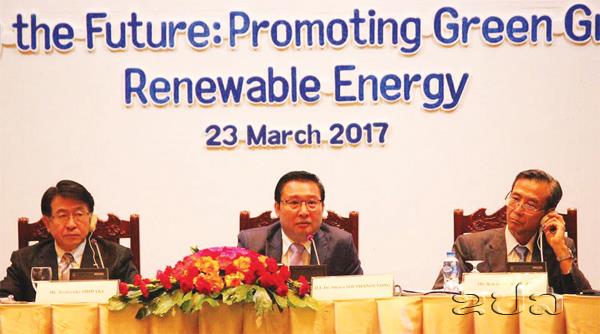KPL
(KPL) Over 70 representatives from the government and international organizations attended a workshop on “Energizing the Future: Promoting Green Growth and Renewable Energy” in Vientiane Capital on March 23.

Deputy Minister of Energy and Mines, Mr Sinava Souphanouvong (C) at a workshop on “Energizing
the Future: Promoting Green Growth and Renewable Energy” in Vientiane Capital on March 23.
Phetsamone Phommuny
(KPL) Over 70 representatives from the government and international organizations attended a workshop on “Energizing the Future: Promoting Green Growth and Renewable Energy” in Vientiane Capital on March 23.
The workshop was co-chaired by Deputy Minister of Energy and Mines, Mr Sinava Souphanouvong, Charge d' Affaires ad interim of Japan to Laos, Mr. Kazunori Kawada, and Managing Director of Hitachi Zosen Corporation, Mr. Toshiyuki Shiraki.
The workshop was held on the basis of the comprehensive cooperation agreement on Green Growth with the Ministry of Energy and Mines.
The workshop was to examine the state of renewable energy development in Laos, analyze key trends and development, highlight new government programmes and discuss new opportunities and key challenges.
The workshop also showcased noteworthy projects and promising technologies for Laos such as reducing energy imports and manufacturing renewable energy.
The objective of the workshop was to examine the state of renewable energy development, exchange knowledge learned from alternative energy project implemented in Laos and study on alternative energy innovation technology.
At the workshop, the Deputy Managing Director of EDL, Mr Komochanh Phet-Asa said that Lao PDR has a large hydro-power potential with estimates varying from 18,000 MW to 26,000 MW, out of which only 14% has been developed so far.
He said that the average generation in the period between 2004-2016 was approximately 2,634 GWh/year, while the trend of exported energy was reduced and the import of energy from neighboring countries was increased to 277 GWh in 2004 and 860 GWh in 2016 ( the average is 844 GWh/year). That means the demand of electricity in the country is higher than the supply. Therefore, EDL must increase its import from neighboring countries.
Currently, EDL exports surplus energy during the rainy season and imports some energy during the dry season, because most of the hydro-power plants are run-off river plants and their capacities are relatively small.
KPL